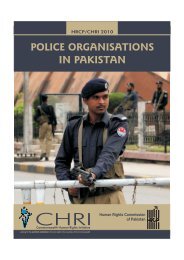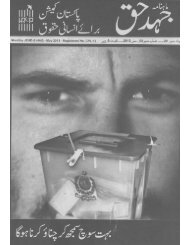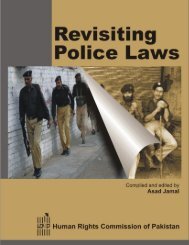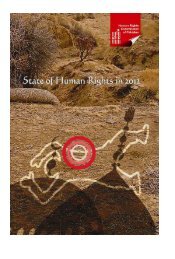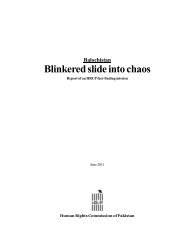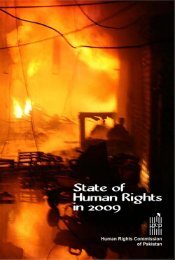Download PDF file - Human Rights Commission of Pakistan
Download PDF file - Human Rights Commission of Pakistan
Download PDF file - Human Rights Commission of Pakistan
Create successful ePaper yourself
Turn your PDF publications into a flip-book with our unique Google optimized e-Paper software.
desired destinations. These roadblocks literally trapped participants, when firing started, as<br />
they were unable to move forward. The roadblocks were steel containers, heavy goods<br />
vehicles, and parked buses with deflated tires; some <strong>of</strong> these roadblocks were manned by<br />
MQM activists (COD) whilst others were unmanned (Aisha Bawany).<br />
It is evident from these three incidents that there was military-style organization among<br />
the armed activists. These activists either took sniper positions in surrounding buildings and<br />
high points (such as bridges), used sophisticated weapons such as hand grenades (Malir), and<br />
again used roadblocks in ways that prevented people from moving freely. There is also some<br />
evidence <strong>of</strong> selected targeting <strong>of</strong> political activists, as many prominent leaders <strong>of</strong> PPP and<br />
ANP were not injured despite their proximity to the firing. This evidence suggests that the<br />
armed activists were well prepared and perhaps given specific instructions. Lastly, emergency<br />
services were prevented from evacuating injured persons immediately. Their assistance could<br />
clearly have prevented deaths, and dead bodies were seen lying on the streets for several<br />
hours.<br />
The other minor ambushes did not seem to be as planned as the aforementioned ones.<br />
MQM supporters returning from a rally in the Patel Para neighborhood were fired at. Patel<br />
Para is largely a Pashtun neighborhood, and it is suspected that Pashtun armed activists fired<br />
upon the MQM rally. This subsequently turned into an armed clash between the rival groups.<br />
There were similar incidents between rival groups in the west and north-west areas <strong>of</strong><br />
Karachi. There was minimal police presence in these areas, and most <strong>of</strong> the violence was<br />
related to the passing by <strong>of</strong> political rallies through areas dominated by rival groups. Each<br />
rival group blamed the other for firing upon them or preventing them from getting to their final<br />
destination. Each rival group nonetheless resorted to violence.<br />
3.3 Armed clashes and cross-fire<br />
HRCP<br />
The armed clashes witnessed on May 12 were mostly a result <strong>of</strong> the ambushes that<br />
morphed into clashes and crossfire between rival armed groups. There were two distinct types<br />
<strong>of</strong> armed clashes on that day. The first is the aforementioned metamorphosis <strong>of</strong> the ambushes<br />
on rival groups and second is the conflict that spread to different neighborhoods. While<br />
ambushes lasted for 2 to 6 hours, neighborhood violence lasted for several days..<br />
The neighborhood violence, particularly along ethnic fault lines in the city, erupted into<br />
mob violence, such as setting a hotel on fire in Qasba Colony or setting the Baans’s 15 shops<br />
on fire in the Lyari neighborhood. This subsequently resulted in armed clashes and cross firing<br />
between rival groups. There are many reports among the different neighborhoods <strong>of</strong> Pashtun<br />
and Urdu-speaking residents being targeted, gruesome killings, and general lawlessness with<br />
free-firing zones. Again, this lasted onto the next day and in a few cases the day after under<br />
minimal security presence.<br />
3.4 Abduction and execution-style killings<br />
There were several cases <strong>of</strong> abductions in various areas from armed political activists<br />
preventing lawyers entering or leaving the Courts, to targeted abductions leading to torture<br />
and/or execution. Although these abductions were conducted in different manners, ultimately<br />
rival groups operated under a similar manifesto.<br />
The most prominent case is MQM armed activists holding lawyers literally hostage at<br />
the City, Malir, and Sindh High Courts. Although this is not typically considered abduction,<br />
26



